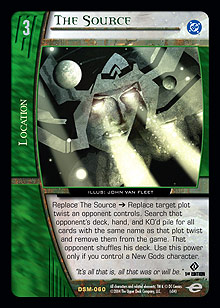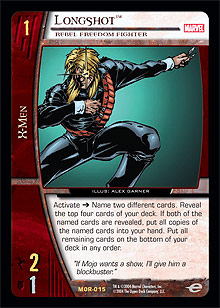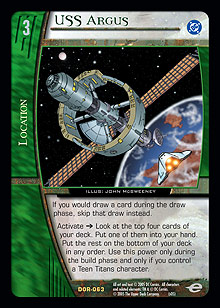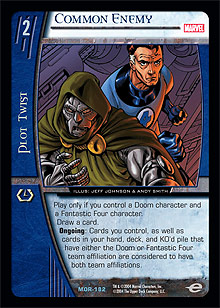
Welcome, my loyal readers, to another exciting installment of Theoretically Speaking! In this episode, I will discuss miniature horses, Curve Sentinels, and why Enemy of My Enemy doesn’t fit in every deck. I know that may sound random, but there are definitely several similarities in each of the above-mentioned items. Can you see them? Yeah, I don’t blame you. The common thread in each of those topics is not readily obvious, so let me put you on the path. Today, I am going to discuss with you what keeps an old deck competitive in a constantly changing metagame.
This is likely the most confusing opening I have ever written. I’m not normally a mysterious guy—actually, I am the epitome of the “what you see is what you get” kind of guy. I heard if you look up Shane Wiggans on Wikipedia you will find the definition of bland (also noob, but that is neither here nor there). I also heard that if you do the same for Tim Batow, you will find all of his TCG accomplishments. One of these statements is true; I will leave it up to you to determine which. Hopefully, as we wade through the waters of over two years of competitive Vs. play, you will see the trends that enable a strong deck to hold onto its competitive edge.
The World’s Smallest Horse!
Today I went to the Tulsa State Fair for the first time since I was somewhere around twelve or thirteen years old. My wife had never been to a state fair before, and since the number of activities available in Oklahoma is limited, we decided to grab my parents and hit the midway. While we were driving there, I recounted my last experience at the fair. Specifically, I remember giving up fifty cents to see what was touted as the world’s smallest horse and laughing at what an awful attraction (if you can call it that) it was. We walked around for a long time; rode the Ferris wheel, the Himalaya and the bumper cars; and finally proceeded to walk toward the exit. And then there it was, in all its glory: The World’s Smallest Horse! What was even more shocking than the fact that the same attraction showed up fifteen years later was that it still only cost fifty cents! I guess inflation hasn’t affected the smallest-horse business much.
What in the world could that story have to do with the Vs. System? The answer is simple, really—being old and on the fringe for a while doesn’t automatically make something bad. So this brings us to our topic of the day: What makes an old deck good and allows it to maintain its success over the many metagame changes and shifts?
The Trifecta
I believe that there are three distinct reasons why certain decks have maintained their competitiveness and staying power:
- Individually powerful cards
- Consistency
- Off-initiative tricks
All three of these factors are present in the Teen Titans, Common Enemy, and Curve Sentinel decks. In order to truly understand how to replicate this success, an analysis of these elements is in order.
Individually Powerful Cards
I know this seems like an oxymoron, but it’s not. There are many cards that, viewed in a vacuum, could be considered among the most powerful ever printed, yet still do not see competitive play. Let me give you a couple of examples: The Source and Spider-Man, The Amazing Spider-Man.
 When The Source came out, New Gods seemed like the team to beat. I mean, this card packed enough power in its punch that the team associated with it had to be good, right? Unfortunately, that was not the case. Although the card itself was insanely strong and could ruin decks like New School or Curve Sentinels, it just didn’t have the support necessary to be a contender. This was because, as you will see below, it lacked the consistency and off-initiative options to pull out those hard wins.
When The Source came out, New Gods seemed like the team to beat. I mean, this card packed enough power in its punch that the team associated with it had to be good, right? Unfortunately, that was not the case. Although the card itself was insanely strong and could ruin decks like New School or Curve Sentinels, it just didn’t have the support necessary to be a contender. This was because, as you will see below, it lacked the consistency and off-initiative options to pull out those hard wins.
Or think about this one: How many decks actually used Spider-Man, The Amazing Spider-Man? Not a lot. His team couldn’t support him, and he wasn’t the most easily splashed character in the world (although this changed somewhat with the inception of Enemy of My Enemy). Again, this card suffered from the same pains that The Source endured. There was no reliable search, and even though Spidey himself was a great off-initiative play, getting to the point where you could play him and still be in a position to win was very hard when he first appeared.
These are just a few instances of individually powerful cards that could not find their places inside competitive decks. Don’t get me wrong—there have been instances where Spidey has shown up in a deck and done well, but it was only after other cards came together and allowed for a consistent way to hit our favorite wall crawler.
So, what about the three decks we are analyzing? Titans has Garth ◊ Tempest; Terra; and Roy Harper ◊ Arsenal, Sharpshooter. Common Enemy has Dr. Doom, Diabolic Genius, and Curve Sentinels has Bastion. All three of these decks sport cards that are recognized in their own right as some of the most powerful cards printed. The question to ask is, what made Teen Titans, Common Enemy, and Curve Sentinels special? The answer to this question is found in the next two sections.
Consistency
 Ah, the key to any deck. You need to have consistency to be competitive. Again, this may seem self-explanatory, but it’s not. Just because you have a consistent deck does not mean that you have a good deck, but in order for a deck to be good, it must first be consistent. Look at Wild Vomit, for example. That deck packed 20 Wild Sentinels and around 15 Sentinel Mark IVs so that it could hit its drops. However, it was not the Army characters that made the deck playable. It was Longshot, Rebel Freedom Fighter. He single-handedly made that deck possible. He was an individually powerful card that also greatly improved consistency and built hand advantage, which was necessary for the deck to remain competitive.
Ah, the key to any deck. You need to have consistency to be competitive. Again, this may seem self-explanatory, but it’s not. Just because you have a consistent deck does not mean that you have a good deck, but in order for a deck to be good, it must first be consistent. Look at Wild Vomit, for example. That deck packed 20 Wild Sentinels and around 15 Sentinel Mark IVs so that it could hit its drops. However, it was not the Army characters that made the deck playable. It was Longshot, Rebel Freedom Fighter. He single-handedly made that deck possible. He was an individually powerful card that also greatly improved consistency and built hand advantage, which was necessary for the deck to remain competitive.
Regarding a deck like Common Enemy, consistency was key in determining how the deck was built. Dr. Doom, Diabolic Genius is clearly the powerhouse of that deck. Unfortunately, when the deck was conceptualized, Faces of Doom couldn’t provide the consistency that was necessary to make the deck competitive. Obviously, when the deck first appeared, there were not a lot of options to team-up with. Of the available teams, only the Fantastic Four—and more specifically, Signal Flare—could provide the stability and consistency that the good doctor required. Considering that there already was a team-stamped team-up, it made good sense for these two teams to come together and make a splash.
Curve Sentinels, however, took a different approach. Instead of having a support team that would give it consistency, it just packed an above average number of characters at each drop. Normally this strategy would spell death for a deck, but it actually turns out to be a benefit to the mean machines. Using cards like Reconstruction Program, the deck is able to power-up out of potential problems as well as rebuild its hand to maximize Bastion’s effect, thus fueling its win condition.
 Teen Titans actually have a couple cards that allow them to achieve the consistency necessary for a top level deck. USS Argus allows a player to see twice as many cards per turn, albeit at the cost of only netting one card instead of the normal two. Another location that helps maintain consistency is Optitron. Obviously, with a high cost of a resource point and a card, this ability is not used often, but its potential curve-fixing effects and its ability to fuel Terra’s power warrant some recognition. Also, the team has built-in 3-drops in the form of the boost effects on Hank Hall ◊ Hawk and Dawn Granger ◊ Dove, which allow the deck to play fewer 2- and 3-drops, freeing up those slots to accommodate other needs.
Teen Titans actually have a couple cards that allow them to achieve the consistency necessary for a top level deck. USS Argus allows a player to see twice as many cards per turn, albeit at the cost of only netting one card instead of the normal two. Another location that helps maintain consistency is Optitron. Obviously, with a high cost of a resource point and a card, this ability is not used often, but its potential curve-fixing effects and its ability to fuel Terra’s power warrant some recognition. Also, the team has built-in 3-drops in the form of the boost effects on Hank Hall ◊ Hawk and Dawn Granger ◊ Dove, which allow the deck to play fewer 2- and 3-drops, freeing up those slots to accommodate other needs.
Consistency, however, is much less of an issue than it used to be. At first, when Weapon of Choice debuted in Marvel Knights, many players claimed that consistency would no longer be an issue in team-up decks. The heavy cost of discarding two cards, however, made this curve-smoother unplayable. It seemed that if your favorite team wasn’t given access to a good search card, then it was destined to be mired in failure. That may be somewhat of an overstatement, but it was really difficult to find a team that was flexible enough to lend its search card to the abundance of teams that were not so fortunate. Then something great happened. The powers that be in the UDE offices heard our plight and presented us with a great and mighty gift: Enemy of My Enemy. This card single-handedly made viable every deck that Michael Barnes writes about. Seriously, I can’t remember a card shaping the metagame like this card has. Before Enemy of My Enemy came around, you were forced to make do with what you could find and hope for the best. Now that there is a strong, available search card, consistency is much less of an issue than it once was. This doesn’t mean that Enemy fits in every deck—most decks composed of teams that have their own search cards will not need to lean on Enemy like other decks will.
As you can see, consistency was a big part of why these decks were able to perform. But consistency without power has a hard time competing. However, there is one more factor that should be considered when trying to make a perennial favorite.
Off-Initiative Tricks
I use the word “tricks” although there is nothing tricky about it. These are the cards that make a “good” deck good. I am referring to those cards that allow you to control tempo and direct the course of the game. Cards like Mystical Paralysis; Search and Destroy; and Heroic Sacrifice have allowed our spotlight decks to maintain their status as some of the best decks available. But why is that? Well, the biggest issue is that some of these cards require a decent level of skill to be used correctly.
It is largely held that Teen Titans is one of the most difficult decks to pilot in the Vs. System. If you haven’t played with this deck, you don’t know the choices that are available to you. You have to decide which characters are worth playing at what time (a decision that every player must make), as well as deciding when to activate Terra, which location to KO with her effect, and what cards to return with Garth. And that is not even getting into the calculations that are required to use Roy Harper ◊ Arsenal, Sharpshooter correctly.
 Even Common Enemy had effects that could sometimes be tricky. Dr. Doom, Diabolic Genius is without a doubt the MVP of this deck. Not only can your opponents not play plot twists as long as you control another non-stunned Doom character, but you also get to reuse a plot twist from your row? That’s crazy talk! I remember at the first Pro Circuit seeing judges explaining to players how you could flip a plot twist like Mystical Paralysis in your row and exhaust Dr. Doom with his ability on the chain so that you could then turn the Paralysis back down. At that stage of the game’s maturity, those kinds of interactions were definitely difficult to follow and hard to understand. Hopefully now, together, we have learned how the chain works and how important it is in getting maximum use out of all of your cards.
Even Common Enemy had effects that could sometimes be tricky. Dr. Doom, Diabolic Genius is without a doubt the MVP of this deck. Not only can your opponents not play plot twists as long as you control another non-stunned Doom character, but you also get to reuse a plot twist from your row? That’s crazy talk! I remember at the first Pro Circuit seeing judges explaining to players how you could flip a plot twist like Mystical Paralysis in your row and exhaust Dr. Doom with his ability on the chain so that you could then turn the Paralysis back down. At that stage of the game’s maturity, those kinds of interactions were definitely difficult to follow and hard to understand. Hopefully now, together, we have learned how the chain works and how important it is in getting maximum use out of all of your cards.
Even Curve Sentinels had their tricks with Micro-Sentinels and Search and Destroy. I expect Search and Destroy to be a thorn in many Checkmate decks’ sides, as it will allow a deck with no real answer for hidden shenanigans to take care of Ahmed Samsarra and the other problematic concealed characters. Granted, many decks are playing Cloak of Nabu to keep these kinds of cards at bay, but there has been a resurgence of counter-tech in the form of Meltdown so that cards which target (such as Search and Destroy) can still provide useful effects.
In the End
I hope you enjoyed our brief walkthrough of what makes Teen Titans, Curve Sentinels, and Common Enemy each a strong deck. When you are building your own decks at home, please take into account those topics that we covered. As always, a good starting point will be with a strong card that can turn the tide of a game. When you have that, look for a build that will provide you with some consistency to hit the drops, plot twists, and locations that you may need. Finally, as you are putting tweaks on your new deck, see if you can find access to some nice off-initiative plays that will allow you to control the ebb and flow of the game. Not every deck will be able to fulfill this checklist, but if you discover one that can, I promise you that you will be on your way to creating a strong and potentially tournament-viable deck. Until next time!
Shane Wiggans, one of the nicest guys with a tattoo sleeve, is also a member of Team Alternate Win Condition and loves small horses if you couldn’t tell. If you have any questions or comments for him, feel free to say hey at any event, or email him at piercedlawyer@yahoo.com.